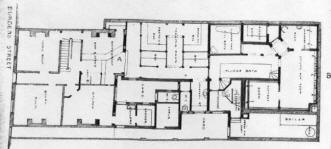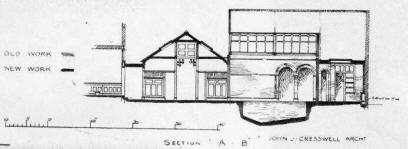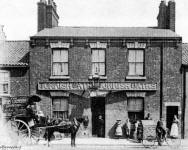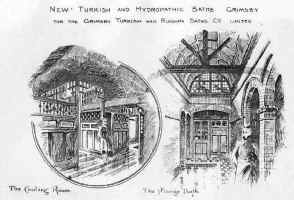Grimsby's Matlock House
In 1870, Samuel Rolley was the proprietor of hydropathic baths at Matlock House in Lower Burgess Street, between Cressey Street and Lower Spring Street.1 Matlock House was a name frequently used by hydropathists who wished their customers to associate their premises with the far grander hydropathic establishments to be found at Matlock in Derbyshire. Rolley had greater justification for using the name, however; he had actually worked at Smedley's Matlock establishment as a bathman.2

This was not Rolley's first business since leaving Matlock. In 1868, he had owned a hydropathic establishment at 135 King Edward Street North3 and, shortly afterwards, other baths in New Market Place—though he does not seem to have stayed there very long. But the baths in Lower Burgess Street, popularly known as the 'Steam Vapour Baths', lasted much longer and he continued to run them for around twenty years.
The Turkish bath is built
In 1891, Rolley sold his baths to a newly incorporated company, the Grimsby Turkish and Russian Baths Company Limited, set up on 24 April specifically to establish, construct, and acquire Turkish baths.4 The sale was atypical in some respects in that the baths' original proprietor did not accept in payment, nor later purchase, any shares in the new company. Nor did he act for the company as its Baths Manager, a position held by Walter Bell who lived on the premises. But it may be that Rolley was ill by this time since he died on 25 October the following year.5
Even after examining the enlarged plan of the building work undertaken by the new company, it is difficult to know with absolute certainty whether Rolley ever installed Turkish baths at any time during his period of ownership. It could be argued that he might have done, since that part of the building marked as being 'old work' includes a boiler and flue immediately next to the position of the new Turkish bath—and locating a refurbished bath in the same position would have made financial sense.
On the other hand, while many hydropathists did include Turkish baths in their establishments, by the 1870s, they were far more popular than traditional hydropathic baths and, if they had been included, Rolley might well have been expected to promote them more intensively by including them in the name of his establishment. On balance, therefore, it seems more likely that he did not instal any.
The new company's architect, John J Cresswell of Grimsby, seems to have added facilities, such as the steam room, cooling-room, and plunge pool by infilling the area behind the original house and the old bath and boiler area (shown in section below).
Rolley's original house, with its attractive thirty foot wide frontage on Lower Burgess Street, now served as the bath manager's house with, on the ground floor, a refreshments bar, an office, and the company's board room.
Immediately behind the main house, a passage led to the cooling-room (with four changing cubicles) and plunge pool. There were also cold water and slipper baths, needle showers, and a shampooing room. The whole of this area was completely new and was decorated in style.6
The two Turkish bath hot rooms, the Russian steam bath, the shampooing room, and the slipper and sitz bathroom were lined with glazed brick. The cooling-room and plunge pool area were of brick, with wooden partitions and decorative screens.
The house had its own four inch bore Artesian well on the premises, sunk to a depth of 120 ft. Water was pumped by a 4hp boiler which supplied piped steam for the Russian bath, heated air for the hot rooms and radiators, and additionally drove the washing machine in the laundry area on the first floor.
Clean air for the Turkish bath entered above roof level and was led over a series of hot cylinders and, after circulating through the various apartments, was drawn off at floor level and discharged into the engine flue.
The Grimsby-based builders responsible for the conversion were Messrs Hewins and Goodhand, while the engineering work and heating were carried out to the architect's designs by the Great Grimsby Co-operative Box and Fish Carrying Company, Limited.
The baths, the laundry, and the company
The baths were open for women on Wednesdays and admission charges for men were reduced at certain times on Thursdays and Saturdays.
The Baths Laundry,7 equipped with all the latest equipment from the usa, and with its own separate entrance, van sheds and stables, was opened a year later in 1893 and was considered to be so well-equipped that members of the public were invited to look round it on Wednesdays.
At the end of 1892, nearly 40 shareholders held 665 of the 2,000 £1 shares offered at the company's launch and, by March 1895, all but 75 of the shares had been issued. Nevertheless, the company was already in financial difficulties and the following year, being unable to meet its debts, Mr Walter M Dawson was appointed liquidator.8
Dawson sold the baths later that year to the company's Secretary, a Mr Hill who ran the baths until he died the following year. It is not quite clear whether his widow, Ellen, owned them until their closure, around 1909. She may have let them to John Nelson Fox, or Fox might have managed them for her; or she may have sold the baths to Fox and managed them for him.



